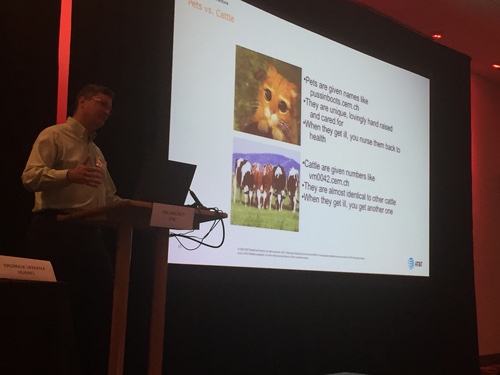First-generation NFV only virtualized functions as they exist today, without breaking them into composable software pieces, says Tom Anschutz.
September 14, 2016

DENVER -- NFV & Carrier SDN -- The telecom industry needs to move quickly past the first generation of NFV, where existing hardware elements are simply virtualized as software, and into the stage in which virtual functions are broken down into simpler pieces of software and managed as part of a cloud services portfolio, AT&T's Tom Anschutz said here Tuesday.
Speaking at Light Reading's NFV & Carrier SDN event, the distinguished member of technical staff at AT&T Inc. (NYSE: T) said the early virtual network functions were hardware functions that vendors virtualized and delivered as software that could run on an x86 server. That was fine for an initial step, Anschutz said, but it created bundles of functions that couldn't be broken down, which limited flexibility. That approach also didn't do anything to simplify management as every vendor's ported software was still managed by its existing element management system, which allowed for rapid adoption but maintained vendor lock-in, he said.
Figure 1: AT&T's Tom Anschutz  Driving home the point about treating hardware as cattle, not adorable little kittens.
Driving home the point about treating hardware as cattle, not adorable little kittens.
"If I had a packet gateway and it was a bundle of functions, the software did the same bundle of things," he explained. "That's okay but it stifles the ability to re-use those functions in other applications."
In the next round of virtualization, things such as routers and gateways must be broken down into smaller functions, with software re-architected to meet future business requirements, he said. That means creating what is, in essence, a catalog of software functions that can be assembled as needed and delivered via a flexible cloud infrastructure in an on-demand, self-service way. Hardware needs to be set up as cattle, not pets -- i.e., easily replaceable commodity systems that don't require special treatment, Anschutz explained.
Want to know more about NFV and open source strategies? Check out our dedicated NFV content channel here on Light Reading.
At AT&T, there are clear business imperatives going forward that start with virtualized, software-based applications and services, but go on to include a shared standard cloud platform, software modularity and re-use, open platforms, and shared standard orchestration, Anschutz said.
"We need decoupled applications/services, which includes not being locked into an EMS," Anschutz said. And when it comes to vendor openness, it's not just a policy interface but an applications programming interface and access to the source code that are important. In addition, AT&T is pushing toward comprehensive automation, using its own ECOMP orchestration platform, which is the key to addressing operational expense challenges. (See AT&T Offers 'Mature' ECOMP as Open Source MANO.)
Moving to NFV will actually create more complexity for operators if it's not done right, he said. "We need to introduce layers of software abstraction to hide the complexity."
The "cloudification" of network software can't address one critical issue, which is the cost per-bit, per-second, Anschutz said. For that, merchant silicon remains the better approach for basic packet forwarding.
"We can have packet forwarding blocks with common network operating systems like OpenDaylight or ONOS, and applications on top of that, that would have been feature functions on switches and routers in the past," he explained. "Then you have high-availability elastic capacity using simple packet-forwarding hardware, which is simple to build and operate."
The combination of SDN, an NFV infrastructure cloud and what Anschutz called "cloud-FV" -- network functions now offered as generic software -- with a common orchestration system, which at AT&T is its ECOMP, is what will deliver the true power of the next generation of virtualization.
— Carol Wilson, Editor-at-Large, Light Reading
You May Also Like









